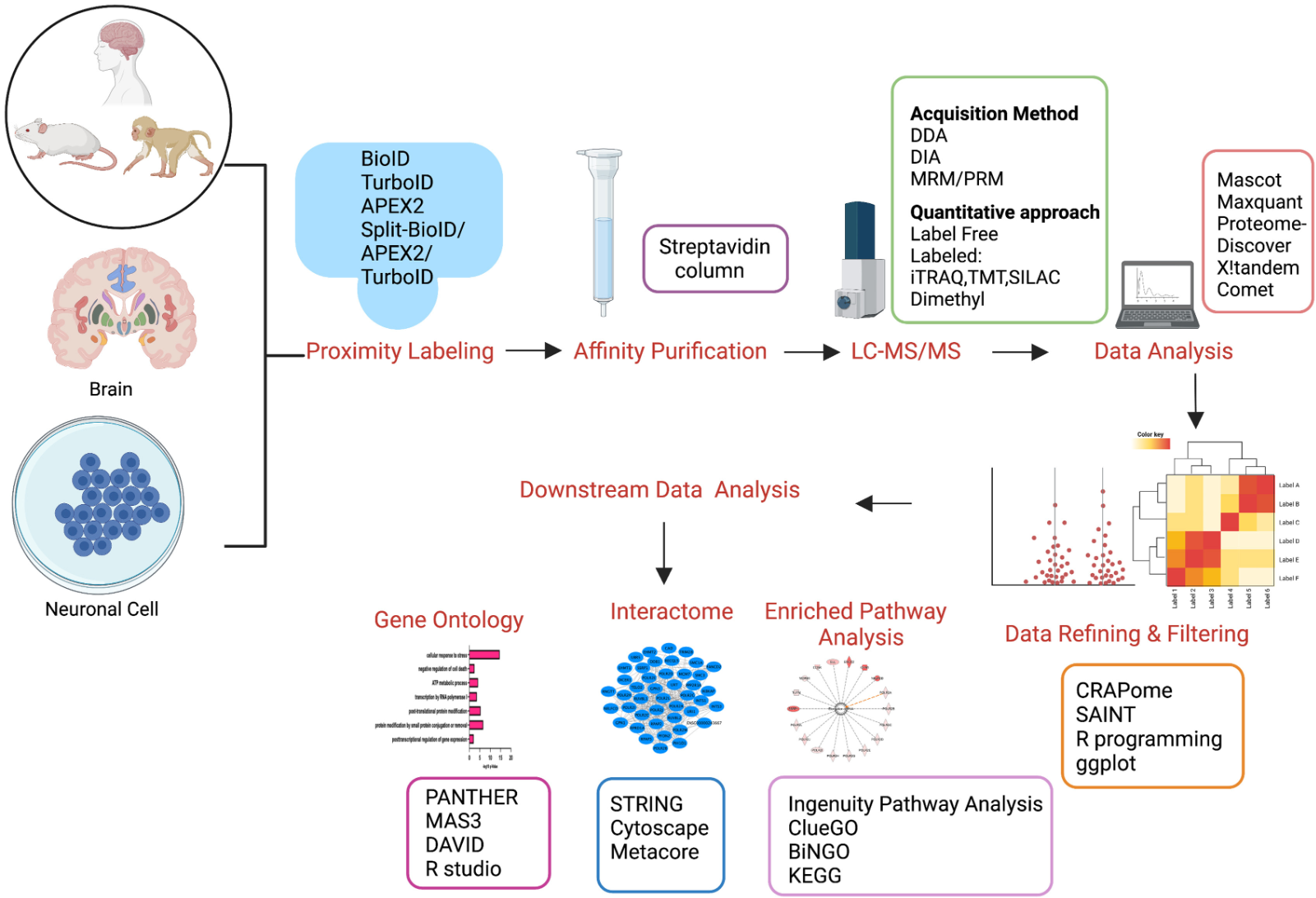Biotin Proximity Labeling Service
Biotin proximity labeling is a cutting-edge technique designed to study protein-protein interactions, subcellular localization, and functional networks within living cells. Biotin proximity labeling method relies on engineered enzymes, such as BioID, BirA*, or TurboID, which catalyze the covalent attachment of biotin to lysine residues on neighboring proteins. The labeling occurs in real-time and in native cellular environments, ensuring minimal disruption to the physiological context of the proteins under study. The biotin-tagged proteins can then be captured using streptavidin beads and analyzed via advanced mass spectrometry (MS) platforms. This approach is uniquely powerful, as biotin proximity labeling enables the identification of transient and weak protein interactions that are often missed by conventional methods.

Figure 1. Principle of Biotin Proximity Labeling Technology
Biotin proximity labeling is widely used to dissect protein interaction networks, map organelle-specific proteomes, and investigate molecular pathways in various biological and disease models. Biotin proximity labeling technique accelerates discoveries in areas such as signal transduction, epigenetic regulation, and drug target identification, by providing precise localization and interaction data. Compared to traditional methods like co-immunoprecipitation, biotin proximity labeling offers unparalleled sensitivity and specificity, enabling researchers to decode complex proteomic landscapes with exceptional detail.
Service at MtoZ Biolabs

Figure 2. Workflow for Mapping PPIs in the CNS Using Biotin Proximity Labeling
Service Advantages
1. High Sensitivity and Specificity
Our Biotin Proximity Labeling Service ensures precise identification of transient and spatially restricted protein interactions, capturing subtle yet biologically significant events often missed by traditional methods.
2. Advanced Analysis Platform
Equipped with cutting-edge Biotin Proximity Labeling Service platforms and advanced labeling enzymes (e.g., TurboID, BirID), MtoZ Biolabs delivers unparalleled accuracy and reliability in data acquisition and analysis.
3. Comprehensive and Tailored Solutions
We provide end-to-end support, including experimental design, sample preparation, mass spectrometry analysis, and detailed reporting, all customized to meet your specific research needs.
4. One-Time-Charge
Our pricing is transparent, no hidden fees or additional costs.
5. High-Data-Quality
Deep data coverage with strict data quality control. AI-powered bioinformatics platform integrates all biotin proximity labeling data, providing clients with a comprehensive data report.
Case Study
Mapping Protein Trafficking and Intercellular Signaling Using TransitID Technology Based on Biotin Proximity Labeling
A recent study developed TransitID, a method based on biotin proximity labeling using a combination of enzymes, to map protein trafficking in living cells with nanometer spatial resolution. By targeting TurboID to the source compartment (e.g., mitochondria) and APEX2 to the destination compartment (e.g., nucleus), proteins were tagged sequentially with biotin and alkyne-phenol substrates. Dual enrichment, via copper-catalyzed azide-alkyne cycloaddition (CuAAC), allowed for the capture of proteins labeled by both enzymes. Subsequent analysis revealed protein interactions and trafficking between cellular compartments like the cytosol, mitochondria, nucleus, and stress granules (SGs). The study also provided insights into SGs’ role in protecting the transcription factor JUN from oxidative stress. Additionally, TransitID was used to identify proteins involved in intercellular signaling between macrophages and cancer cells. The TransitID technique, based on biotin proximity labeling, provides the ability to track proteins with high specificity and spatial precision, combined with mass spectrometry, offering a powerful tool for studying dynamic protein interactions and cellular responses.

Qin, W. et al. Cell. 2023.
Figure 3. Development of TransitID and Characterization of APEX-Catalyzed Alkyne-Phenol Labeling
Deliverables
1. Comprehensive Experimental Details
2. Materials, Instruments, and Methods
3. Total Ion Chromatogram & Quality Control Assessment (project-dependent)
4. Data Analysis, Preprocessing, and Estimation (project-dependent)
5. Bioinformatics Analysis
6. Raw Data Files
Our Biotin Proximity Labeling Service is designed to provide more rapid, high-throughput, and cost-effective analysis, with exceptional data quality and minimal sample consumption. Free project evaluation, welcome to learn more details.
MtoZ Biolabs, an integrated chromatography and mass spectrometry (MS) services provider.
Related Services
Label Transfer Protein Interaction Analysis Service
MS-Based Protein-Protein Interaction Identification Service
Pull Down based Protein Analysis Service with Mass Spectrometry
How to order?







